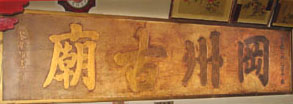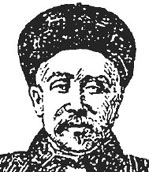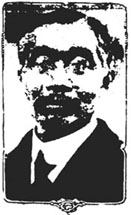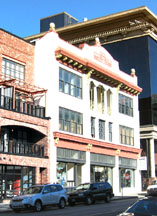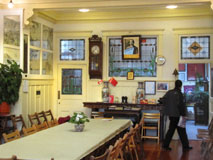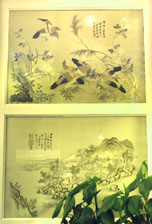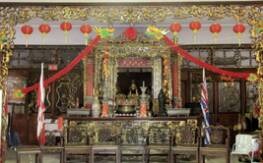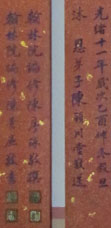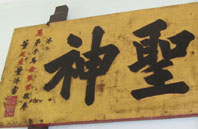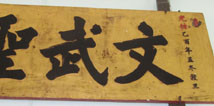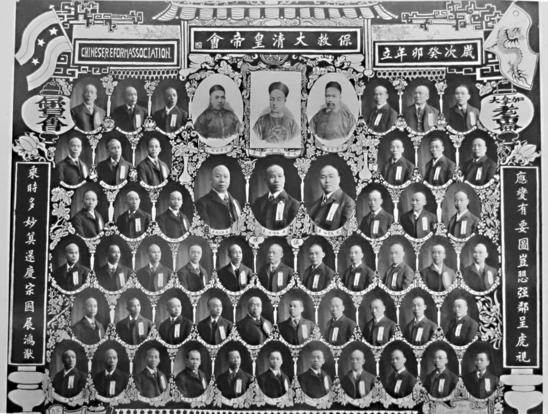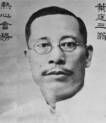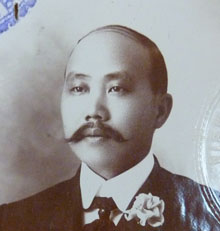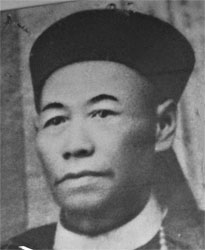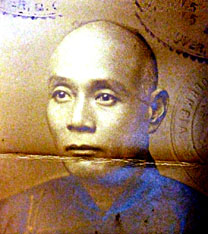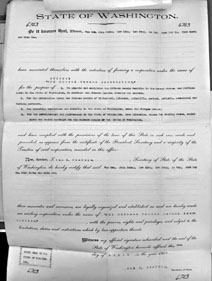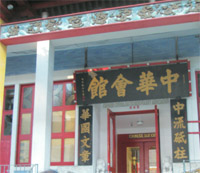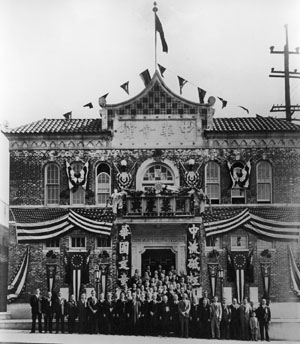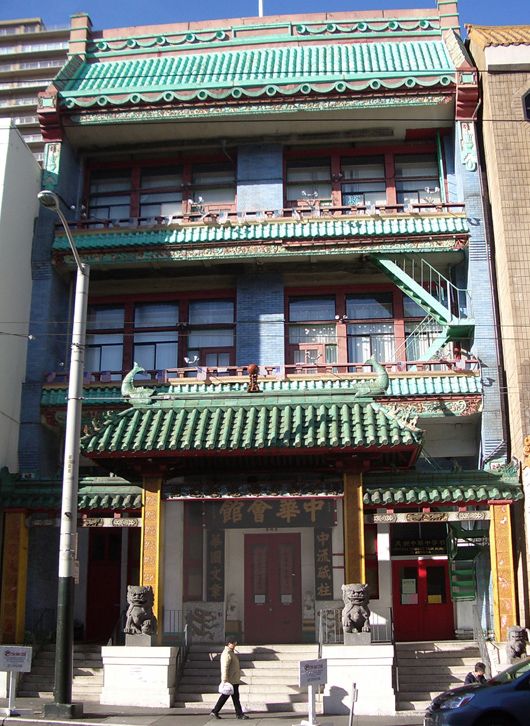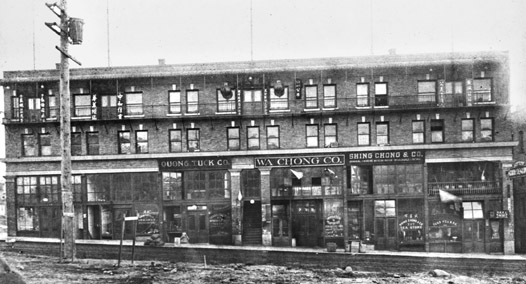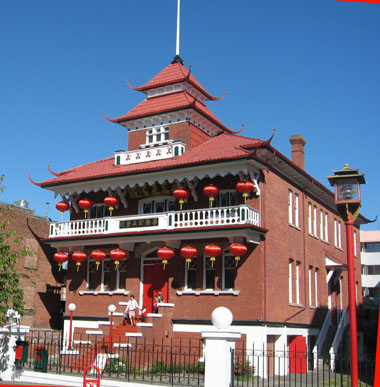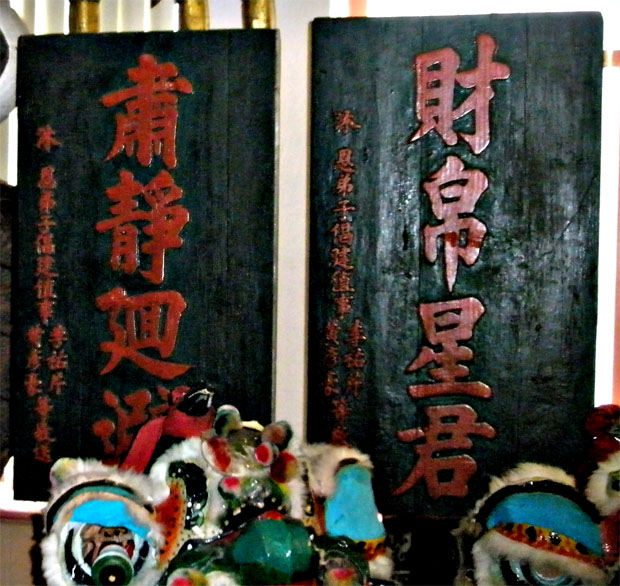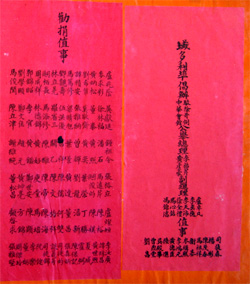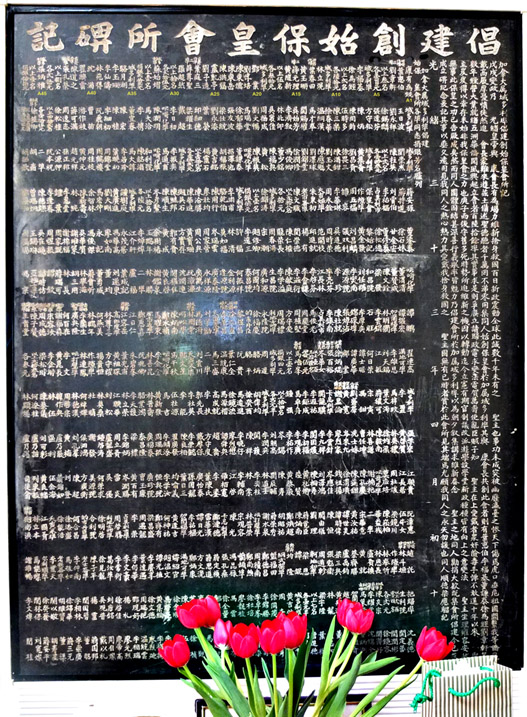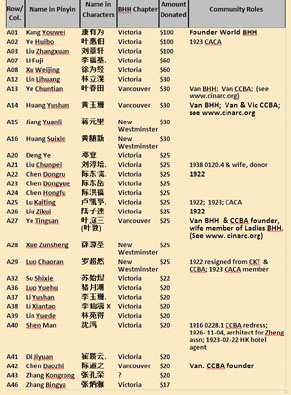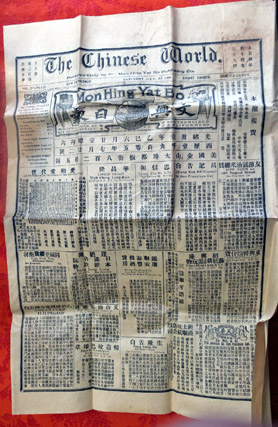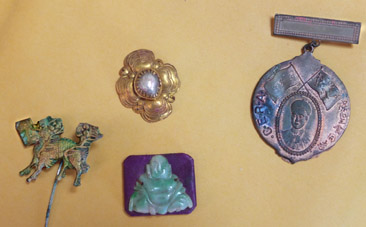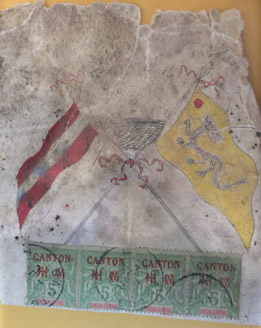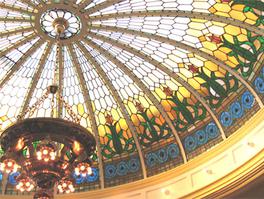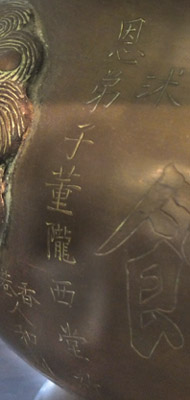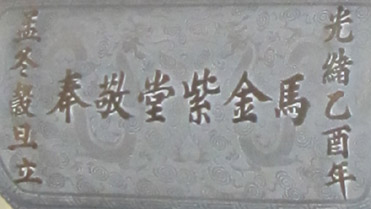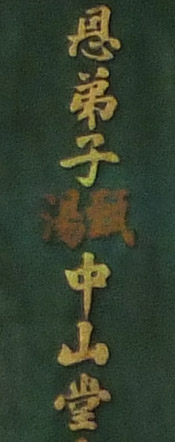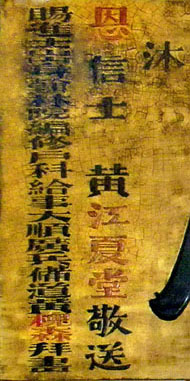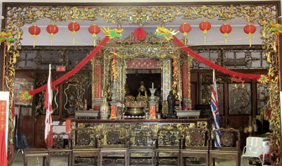Chinese in Northwest America Research Committee (CINARC)
ASSOCIATIONS - HUIGUAN, GONGSI, ETC 会馆.公所
This page presents ideas and data on the secular non-commercial and non-political organizations that once structured (and for many, still affect) the lives of Chinese in North America. Those organizations include family name groups, often called clans, and regional origin groups. Secret societies and religious institutions are not covered here. For those, the user should click on the Secret Societies and Shrines pages.
Many essentially secular associations maintained places for religious rituals and sometimes full-scale temples. In such cases, the religious aspects of those associations are discussed on the Shrines page while other aspects appear here..
The website of the Seattle's branch of the national Chinese Consolidated Benevolent Association 中华会馆, locally known as CWBA, indicates that the organization came into being in 1915. Community historian Douglas Chin dates it to the first decade of the 1900s. The Civil Rights and Labor History Project adopts a middle way, stating that the association is as old as 1910. Other sources tend to accept that the Seattle branch of the national CCBA was established after 1900.
New information is now available that pushes the date back to almost a decade earlier. Early accounting records of the association have survived, kept in the offices of a private Chinatown company. It turns out that some of these records bear dates as early as 1892. We thank Richard Kay for sharing this data. It is even possible that the date of founding could go back a little earlier, as the organization seems to have already established a routine document-handling procedure by 1892.
对联情意结 - 三藩市与西雅图两地的中华会馆 [12/30/11]
福善有堂 [05/24/10]
Empire Reform Association history 叶恩, 叶敦, 是一? 是二? [06/02/12]
A New Date for the Founding of Seattle’s Chinese Consolidated Benevolent Association (Chong Wa) 西雅图中华会馆何时成立
Unlike today's thoroughly secular Chong Wa, the association originally housed religous faciltities. On the 2nd month of 1892 it bought a set of ritual material at $2.50, including three types of sacrificial meat plus altar candles. Ten days later, the Association paid $1.25 for a pair of altar candles and a box of mixed sweets, perhaps also for an offering (Fig. 1).
The Association's 1893 February accounting report shows that it had a $479.52 surplus. The multiple red seals, which probably meant review and approval, belonged to Chin Gee Hee’s Wa Chong Company 陈宜禧. 华昌. Another noticeable entry on this page is the mention of Lew King 刘乾, who was reimbursed $6.50 for 1892 expenses. Lew King was second only to Chin Gee Hee in influence within the local Chinese ciommunity. We may assume that those two businessmen were moving forces behind the establishment of Seattle’s Chong Wa (Fig. 2).
-- Douglas Chin, 2009. Seattle’s International District, the Making of a Pan-Asian American Community, p49. Seattle:

 International Examiner
International Examiner
-- William Hoy, 1942. The Chinese Six Companies, A Short General Historical Resume. San Francisco: CCBA
-- Hin Mark Lai, 2004. Becoming Chinese American. Walnut Creek: Altamira
-- http://www.chongwa.org/ChongWa/index.shtml
-- http://depts.washington.edu/civilr/organizations.htm#chong%20wa
-- Seattle Chong Wa Benevolent Association documents reproduced here with the permission of Dick Kay.
San Francisco's Chong Wa, known to the white media as the Six Companies, had existed in a loosely organized form since about 1862 but did not gain national status until its official recognition and restructuring by the Imperial government in 1882 (see Lai 2004). Although from then onward both Chinese officials and California newspapers considered CCBAs in other cities to be mere satellites of the one in San Francisco, those other CCBAs may not have seen their position in quite that light. In fact, both the San Francisco Chronicle (1898-10-21) and William Hoy, official historian of the CCBA, suggest that San Francisco's CCBA was greatly weakened by the power of secret societies between the early 1880s and the early 1900s.
Seattle's Chong Wa building as of 2008 1929落成西雅图中华会馆新馆址
Fig. 1. Page from Chong Wa (Seattle) accounting report, Rencheng cyclical year (1892)
Fig. 2. Page from Chong Wa (Seattle) accounting report, Guisi cyclical year (1893)
The Kong Chow Temple in San Francisco – Prestige from Diplomats' Calligraphy 三藩市1909年岡州会馆重建 - 权贵显赫门楣
Destroyed in San Francisco’s great earthquake and fire of 1906, the headquarters and temple of the Kong Chow Benevolent Association were rebuilt in 1909 at their previous location on Pine Street [see below, Oldest Temple]. Elders of the Association used this as an opportunity to ensure the goodwill of top-ranking Chinese diplomats, who in those days had real power over American Chinese. Four groups of plaques in white marble were commissioned, and four key Chinese foreign service officials asked to compose and write out suitable inscriptions. All four complied--after all, Kong Chow had important connections within China as well as in California. Three of the four signed their names without adding their official titles, probably as a gesture of friendship. The plaques are now at the enrance to the Association's temple in its new location on Stockton Street
1. Lintel “Kangzhou [Kong Chow] Huiguan [Association]” in gold on white marble, 1909. Calligrapher: Wu Ting Fang of Xinhui, 2 seals.
The best of the best – who could be more suitable than Wu Tingfang? A native of Xinhui, one of the several Taishanese-speaking counties from which the Association's members came, Wu may have been the best-known and respected diplomat in the Qing dynasty government, noted for his excellent English, witty interviews and lectures, and able defense of his nation's interests. Attached to the Chinese foreign service since the 1880s, he served as the Chinese minister plenipotentiary (i.e., ambassador 清朝驻美国使臣) to Washington from 1897 to 1903, and again from 1909 to 1910. He visited San Francisco in 1878, 1897, 1903, and 1909 The Kong Chow Association gave a banquet for him in 1897 and must have given one to his wife as well when she stayed in San Francisco for several months in 1901. San Francisco's Chinese may have felt they owed a special debt to Wu because of his efforts in 1897 to settle once and for all the bloody conflict between the Taishanese-apeaking Sze Yup ("Four County") and the Cantonese-speaking Sam Yup ("Three County") factions in Chinatown
2. Vertical couplet with 5-word lines in gold on white marble, 1909. Donor: Kong Chow Association of Los Angeles. Calligrapher: Hsu Ping Chen. 2 seals.
Hsu Ping Chen [pinyin: Xu Bingzhen] was the General Consul in San Francisco 驻美国旧金山总领事between 1908 and 1910. A native of Panyu in Guangdong (and hence a Sam Yup rather than a Sze Yup), Hsu took up the job shortly after his assignment in Japan to study copper mines. His outsider Sam Yup status may be why, unlike his colleagues, he chose to use his full title on the inscription. He visited Seattle in 1909 and toured the Alaska-Yukon-Pacific Exposition. He may not have liked it--he returned to San Francisco just before the Washington Chinese community's much-anticipated China Day.
Couplet celebrating the Association.
Detail showing Hsu's name, title, and seals
3. Lintel “Kangzhou Gumiao" [Old Kong Chow Temple] with text in gold on white marble, 1909.
Calligrapher: Lei Yung Yew [Li Rongyao]
Lei Yung Yew [pinyin: Li Rongyao 驻美国旧金山总领事], a Cantonese and the successor of Hsu in the position of Consul-General, came to San Francisco in March, 1910. He stayed on for the same job after the new Republic replaced the Manchu imperial government in 1911. At the time the lintel was made, this well-seasoned diplomat was still the Consul-General in Cuba, after a short time in the Philippines. It is hard to believe that he was asked to contribute while far away in Cuba. The lintel must have been added after Lei came to America.
4. Lintel “Qiao Mei Xin Sheng" [Voice of American Chinese] with text in gold on white marble, 1909. Composer and calligrapher: Yung Kwai].
It was a bold step for the Kong Chow Association to recruit this showy piece from Yung Kuai [pinyin: Rong Kui], who at the time held a semi-official position with the Chinese Ministry in Washington D.C. A native of Xiangshan [Zhongshan county] in Guangdong, Yung had been one of the famous group of government sponsored students 官派赴美幼童留学生who came to Yale in the 1870s under the leadership of his uncle, Yong Wing 容闳. When the government called the students back to China in 1882, Yung was one of only two who refused to go. Through arrangements by his uncle, he was able to finish his studies. In spite of the displeasure of conservatives in Beijing, his fluent English and excellent connections with Chinese Americans earned him a long-term job as translator and chargé d’affaires for the Ministry. Chinese in California, whose relations with Beijing officials were not always good, may have regarded him as someone at the Ministry whom they could trust. They may also have been impressed by the fact that he was one of the first Cantonese natives to earn an Ivy League degree.
Wu Ting Fang 伍廷芳
San Francisco 1897.
Hsu Ping Chen 許炳榛
San Francisco 1908-10.
Lei Yung Yew, 黎荣耀
San Francisco, 1910
Yung Kwai 容楑,
ca. 1910
Notes on sources: For Wu Ting Fang in San Francisco, see S.F. Chronicle 1897-04-12, 13, 14, 15; 1901-05-29; 1902-11-24, 25; 1908-03-01; New York Times 1908-02-29. Also see Linda Pomerantz-Zhang, 1992, Wu Tingfang (1842-1922): reform and modernization in modern Chinese history. For Yung Kwai in San Francisco, see Chronicle 1909-08-04; 1910-09-11. Because Lei (or Li) Yung Yew and Hsu Ping Chen both were stationed in San Francisco for several years, they are frequently mentioned in contemporary California newspapers.
An Art Nouveau Landmark: Victoria's Hook Sin Tong Building 巍巍大厦. 福善有堂
One of the most extraordinary Chinese interiors in North America was commissioned by the Hook Sin Tong, a society founded in Victoria BC by immigrants from Heung Shan 香山 (later Zhong Shan) in Guangdong. As in other Canadian and American Chinatowns, the meeting halls of most Chinese organizations in Victoria were decorated in an eclectic traditional style, often with Daoist shrines at one end, a balcony at the other, rows of chairs that might or might not be imported, and miscellaneous signs, posters, and photographs that had accumulated over the years. Not so the Hook Sin Tong building, however. When it was rebuilt in 1911, the architect, one C. Elwood Watkins, seems to have been instructed by the Society to work out an comprehensive interior design that integrated Western-style stained glass, then very popular in China, with specially commissioned art and a color scheme featuring ivory white rather than the usual red, gold, and smoky gray.
The Society must have taken the lead in choosing the art. It contacted the then-famous Binhua embroidery school 缤华艺术学校 in Guangzhou to order a large number of needlework replicas of paintings by prominent artists. These were installed in recessed, glass-covered panels, alternating with inset mirrors and calligraphic texts. In the rear of the room, opposite the balcony where one would normally expect to see a shrine, hung a picture of Sun Yat-Sen, the first president of the Chinese Republic and Heung Shan/Zhong Shan's most famous son. Along both sides were the usual dark wood chairs, of excellent quality, and set into the ceiling was a splendid stained glass dome.
Victoria's other Chinese societies must have been astonished to see such a non-traditional hall. Some must have felt that it symbolized the radical changes in China that were taking place in 1911, the year the Hook Sin Tong was built, when the Chinese revolutionaries under their own Sun Zhongshan, succeeded in overthrowing the Imperial Manchu government and founding the new republic.
Thanks to the foresight of the leaders of the Hook Sin Tong, the hall is unusually well preserved. Although not on the standard Victoria tourist route, it is open to the public on certain days of the year. We will post information here about those open days if the society gives us permission.
Hook Sin Tong building, Herald Street, Victoria卑斯省域多利福善堂
Hook Sin Tong, 3rd floor main hall, east wall
Hook Sin Tong, 3rd floor main hall, rear wall
Hook Sin Tong, 3rd floor main hall, west wall
Hook Sin Tong, 3rd floor main hall, ceiling dome
Hook Sin Tong, main hall
Above: Sparrows & crysanthemums. Emboiderd by Binhua female student Li Mulan. from painting by Wu Baotian.
Below: Landscape in late autumn, with poem. No embroiderer listed, from painting by Wu Baotian
The editors owe sincere thanks to Henry Low, treasurer of the Hook Sin Tong and expert on Victoria's history, for access, advice, and explanations. More data on the Society can be found in Robert Amos & Kileasa Wong, Inside Chinatown, Ancient Culture in a New World, Touchwood Editions, 2009, pp 57-60, and in http://history.book.163.com/10/0211/14/5V8GEEL8009244K2.html
The CCBA's Meeting Hall and Shrine in Victoria: Prestige from Home Town Heroes 加拿大域多利埠中华会馆大堂
town to do the composing and calligraphy. These clanship and home town connections must have made the individuals, who like all high officials would have been skilled with the writing brush, more willing to do the work. The connections must also have been a matter of pride to the organizations and their leaders who would have been eager to show off their elite connections back in China and, quite possibly, their good taste in appreciating fine calligraphy. The plaques helped to prove that they were not just shopkeepers, a low-status occupation in traditional China, but cultured and educated persons, able to communicate as near-equals with the mandarin upper classes who had long controlled the imperial government.
Here are four examples of notable plaques presented to the Victoria CCBA; they were shown to the editors by Kileasa Wong, editor of the Victoria Chinatown Newsletter and secretary of the CCBA.
2. Vertical couplet with long text in
black on red. 1885.
Donor: Chen Family Name Association,
Ying Chuan branch
Composer: Chen Xuqiao陈序球
Calligrapher: Chen Jingshu. 陈景庶?
3. Horizontal plaque with 4 character text and in black lacquer on gold. 1885.
Text: 文武聖神[ Wenwu shengshen - "Cultural and Military Sacred Immortal"]
Donor. The Ma Family Name Association, Jinzi Branch. 马金紫堂.
Calligrapher: Dong Qigeng 董起庚 (1838 – 1900?). A native of Panyu from the Sam Yup [Three-County] region of
Guangdong, Q. G. Dong received his provincial level degree in 1875 and taught at a prestigious local college. His
calligraphy and paintings were much admired during and after his life.
4. Horizontal wooden plaque with 4-character text in black lacquer on gold. 1885.
Text: 海域蒙庥 [Haiyu mengxiu -"Coastal Region Receives Protection"]
Donor: The Huang Family Name Association, Jiangxia Branch. 黄江夏堂.
Calligrapher: Huang Huaisen黄槐森 (1829-1902). A renowned scholar and historian, H.S. Huang got his national first-
rank Jinshi degree in 1862 and was an outstanding educator. He is credited with having created three high quality
schools in his home town near Macau, as well as the former Guangxi provincial university.
Chen Association, Ying
Chuan Branch Plaque, 1885
Chen Association, Ying
Chuan. Plaque (Detail),
Ma Family Plaque, 1885
Huang Family Plaque, 1885
Huang Plaque,
1885 (Detail)
CCBA shrine at Chinese Public School, Victoria
1. Horizontal wooden plaque with a 4-character text in gold lacquer on red, dated 1885.
Text: 會其有極 [Huiqi youji -"Most Superior Gathering"]
Donor: the Chen Family Name Association, San Francisco.
Composer: Chen Lanbin 陈兰彬.清朝首任驻美国使臣. Chen
was the first Chinese Ambassador to the United States, Spain,
and Peru between 1878 and 1881. His fame rests heavily on
being the official who with Yong Wing led the first batch of
Chinese students to study in the United States in 1871. While
it was the Victoria CCBA’s glory to receive LB’s congratulations,
it was San Francisco’s Chen family who persuaded him to help.
Calligrapher: Chen Huaju 陈華聚, who was a
national first-rank Jinshi degree holder and a native
of Xinhui in the Sze Yup [Four County] region of
Guangdong. H.J. Chen probably knew some of
the Victoria Chens who also came from Xinhui.
Chen Famly Plaque (Detail)
Chen Famly Plaque
Note 1. Lai's book will offer a unique historical overview of Victoria's Chinese Consolidated Benevolent Association and of related associations in other Canadian cities. It is the only treatment of such a subject in Canada or the U.S. to represent a neutral insider's viewpoint, based on a North American Chinese organization's official Chinese-language records. Lai, David Chuenyan, Chinese Community Leadership: Case Study of Victoria in Canada, Singapore: World Scientific Publishing Co., 2010. Preorder from www.worldscibooks.com/eastasianstudies/7622.html
版权 Copyright is free for non-profit use: : click here for more information
The Chinese Empire Reform Association (CERA) in Vancouver, B.C. 1899
加拿大温哥华保皇会 1899
The Baohuanghui, known in English as the Chinese Empire Reform Association, had a good many branches -- according to Jane Leung Larson, more than 150. For those interested, extensive discussions of the Baohuanghui in North America can be found on the Baohuanghui Scholarship blogspot, which Larson founded.
The branch in Rossland, on the other hand, must have existed mainly on paper. The town is in southeastern British Columbia. It had only a handful of Chinese residents, and those it did have were poor and marginalized. The Rossland Museum includes a small exhibit of local Chinese artifacts and photographs. All were of gardeners and laundrymen. None were of even small merchants. Like other underground mining areas that produced gold and other metals, Rossland barred Chinese from work in local mines and smelters. This meant that in Rossland and its neighborhood, there was much prejudice, little opportunity for non-whites, and very few Chinese.
The branch in Vancouver was one of the oldest anywhere, having been founded by Kang Youwei himself in 1899 and being supported by a large and wealthy Chinese community. As this picture shows the branch counted the leading men of Chinese Vancouver among its members. Wives of some members later became members of the Association's Ladies branch. The Association address was at 29 Dupont Street, the same address used by Charley Yip Yuen (Yen) and the Yip Sang.Company.
And yet here is a photograph showing no fewer than 52 members of the Baohuanghui's Rossland chapter, each wearing a Western suit and tie and looking as prosperous as members in Vancouver. How was this possible? Is it conceivable that more than a handful of Rossland's poverty-stricken Chinese laborers owned a suit, not to mention a necktie, and that they all had Western haircuts? How could all of them have begun dressing like fashionable white Canadians when, only four years previously, most Baohuanghui members in rich, progressive Vancouver were still wearing traditional Chinese clothes?
Close inspection of the picture reveals the answer: the men in the photograph did not usually, or ever, dress that way. They all are wearing the same coat and the same one or two spotted ties, and all have pigtails that are carefully concealed in back. Even the large tag on their lapels may be the same one in each photograph. The photographer has done a nice job and his picture seems to offer yet more proof of the reach of the Baohuanghui and the wealth and influence of its members. Unfortunately, however, this particular picture is a fake. That Rossland ever had a functioning BHH branch seems doubtful and, if it did, the branch was nothing like this.
A B C D E F G H J
.
1
2
3
4
5
The Pinyin readings of names are in boldface, and the names as used in English-language documents, mostly Cantonese or Taishanese readings, are in brackets with quotes.
-1A. He Zhenxiang 何振祥 ["Ho Jun Chung"]. Vice President.
-1B. Ye Chuntian 叶春田 [or "Yip Sang"]. Auditor. Owner of the Wing Sang Store and dominant
community leader. Later in 1904 most of the female members of Yip Sang's family became
board members of the Empire Ladies Reform Association (CELRA).
-1C. Huang Yushan 黄玉珊 ["Wong Soon King"?]. Treasurer. Also a founding member of
Vancouver's Chinese Benevolent Association [CBA 中华会馆] which was conceived in 1895
and registered in 1906. Huang was also the president of the Victoria CCBA in 1889.
-1D-F Logo. "Winter, Guangxu 25th year" [end of 1899 or early 1900]
-1G. Chen Cai 陈才 ["Chan Choy"]. President.
Founder and owner of the wealthy Sam Kee Company 三记 at 48 Dupont St..
-1H. Li Qingchi 李清墀 ["Lee You Chung"?]. Banker.
las, Won spoke Chinook, Cantonese, Hakkanese, and English. A well-known community
leader and activist, he had lived in Victoria (where he worked for the King Tye Company 乾泰)
and New Westminister before coming to Vancouver.
- 2A. Xue Shengjiao 薛圣教 ["Seid Sing Gaw"]. Board Member.
- 2B. Zhu Bifeng 朱碧峰. Board Member.
- 2C. Lin Deshao 林德绍. Board Member.
- 2D. Ruan Lindeng 阮连登 ["Goon Ling Dang"]. Vice President.
- 2E. Ye En 叶恩 ["Yip Yen", "Yip Yuen", "Charley Yip Yen"]. President of CERA of Canada:
Interpreter and agent for Canadian Pacific Railway, a nephew of Yip Sang 1B, brother
Association. His break with the Baohuanghui in 1909 caused many Chinese Canadians to turn  to more revolutionary politics.
to more revolutionary politics.
- 2F. Ou Zhuofeng 区卓峰. Vice President.
- 2G Huang Tingshi 黄挺世. Board Member.
- 2H. Ma Bao 马保. Board Member
- 2J. Li Wen 李文. Board Member.
- 3A. Ye Mingpu 叶明莆. Board Member
- 3B. Li Xueyi 李学溢. Board Member
- 3C. Huang Liang 黄良. Board Member
- 3D. Ye Zhongwen 叶仲文. Board Member
- 3E. Ye Tingsan 叶庭三. ["Yip On" 叶敦 or "Yip Hing Sam"] Secretary. Also a founding
board member of the Empire Ladies Reform Association.
Board Members below:
- 3F.. Zhou Zhen 周珍
- 3G. Zheng Ping 郑平
- 3H. Lu Zhuoguang.卢焯光
- 3J.. You Tianyang.忧?天养
- 4A. Liang Rushan. 梁如珊 ["Samuel Long"], a native (and citizen) of he United States and
- 4B. Li Jin. 李进
- 4C. Lin Yan. 林炎
- 4D. Ma Xing. 马兴
- 4E. Huang Yongsan. 黄永三
- 4F. Ma Qi. 马漆?
- 4G. Chen Hetao. 陈鹤涛
- 4H. Zhou Sui. 周遂
- 4J. Chen Mingpu. 陈铭浦
- 5A. Zhou Jintang. 周锦棠. He may be the same as 周棠, one of the Zhonghua Huiguan founders
in Vancouver
- 5B.. Zheng Maosi. 郑茂泗
- 5C. Wu Xiu. 吴优
- 5D. Huang Lianjiu [Wong Lin Sue?]. 黄连就
- 5E. Zhen Chang. 甄昌
- 5F.. Zhou Song. 周松
- 5G. Li Youhong. 李佑黉
- 5H. He Can [Ho Chan]. 何火粲
- 5J.. Sun Zhengbang. 孙正邦
The Chinese Empire Reform Association (CERA) in Rossland, B.C. 1903
加拿大卑斯省老市仑保皇会 1903
Yip On (3E) after 1909
Wong Soon King (1C) after 1906, dressed in a Qing official outfit.
It is worth noting that there was indeed a sizable gathering of Chinese in Rossland in 1903. About 100 Chinese "clad in gorgeous regalia" who gathered in October of that year caught the attention of the local newspaper, The Rossland Miner. The reporter noted that the regalia-clad group had come for the opening of the new building of the Chinese Freemasons, or Chee Kung Tong, in Rossland. At least some of the group came from other parts of B.C., and the celebration appears to have gone on until October 27. By contrast, the Miner seems not to have been aware of a local CERA/Baohuanghui. Is it possible that that there was some sort of connection between the two organizations, the Chee Kung Tong and the Baohuanghui? In other places, the elitist Baihuanghui and the more populist Chee Kung Tong did not get along together. But who knows what might have happened in remote Rossland?
References:
Original copy of the photograph in Vancouver Public Library VPL26814
Rossland Miner, 1903 Octobter 13, and October 27.
Won Alexander Cumyow (1J), 1904
Yip On (3E) in 1904
Samuel Long [4A] in 1904
Chan Choy (1G), 1909
References:
The original of the photomontage is in the Vancouver Public Library VPL26691. The other photographs are from National Archives & Records Administration, Seattle. File Sumas 51-1054; Sumas 3-62, ____
For more about Vancouver CERA, see slso http://www.cchsbc.ca/category/ask-larry/
The 100th Anniversary 1906-2006 of Chinese Benevolent Association of Vancouver, pp. 43, 53.;
Paul Yee (1986) "Sam Kee: A Chinese Business in Early Vancouver", B.C. Studies, No. 69-70, pp.70-96; and
L. Eve Armentrout Ma, Revolutionaries, Monarchists, and Chinatowns: Chinese Politics in the Americas and the 1911 Revolution. Honolulu, 1990
Philip Choy, Canton Footprints: Sacramento's Chinese Legacy. Chinese American Council of Sacramento, 2007
See also Jane Leung Larson's Baohuanghui Scholarship blogspot
The editors have just (in 4/2011) been told that another Baohuanghui photomontage exists, showing members of the Sacramento chapter in 1904. It was made in the same way as the others: an Association worker mounted photos of members behind a pre-printed cardboard mat with oval cut-outs through which the photos would show; members' names were hand-written under each photo. We are currently obtaining a higher-resolution version from Phil Choy, who published the Sacramento montage in his Canton Footprints, p 113. The original is housed in the Sacramento Archives and Museum Collection Center.
The Sacramento Baohuanghui, 1904
1903 The Seattle chapter of the Preserve-the-Emperor Association is incorporated 舍路保皇会注册文件
The Baohuanghui, usually translated as "Empire Reform Association" but literally the "Preserve the Emperor Association" did not succeed in forcing the Dowager Empress to resign or in warding off the democratic revolution being preached by Sun Yat-sen and his peers. However, it is important in the history of North American Chinese because it offered those Chinese, despised as mere merchants and laborers by the mandarin elite who ran imperial China, a chance to gain respect from the upper classes. The Baohuanghui's key members belonged to the elite. Yet they needed money, and the best source for that were wealthy emigrant Chinese in such places as North America, Southeast Asia, Australia and the Pacific. The result was a rise in social status for the merchants and, as would be seen in 1906 during the visit of Price Tsai, an unwontedly democratic attitude on the part of visiting officials.
The Association was founded in British Columbia in 1899 and seems to have already been active in Washington State by the time its members decided to incorporate as a charitable organization. In June of that year, 1903, Liang Qizhao, a leader of the Baohuanghui in China, visited Walla Walla, Seattle, and Portland. He commented favorably on the activities of the Baohuanghui in all three places, adding that Seattle was "the driving force for the Association [which he called the Weixinhui] in America."
The incorporation document shown here is not forthcoming about the true purposes of the Association. Although promoting knowledge of Chinese culture, not to mention temperance and morality, were worthy goals, they did not relate closely to the Association's plans for fundraising and, ultimately, replacing Dowager Empress Cixi with an enlightened emperor who would promote modern education, western science, and economic development. Being in favor of these things in China was risky, which is why one has to admire the Seattle Chinese who signed their names to the document: Woo Gen, John Seung, Lew King, Lew Jong, Lo Kay, Mark Hoy Qu, Chin Quong, and Chin Kee.
The document is from the Washington State Archives, Puget Sound Branch, in Bellevue, incorporation file #6703; the quote from Liang Qizhao has been translated from the {Chinese-language) diary he kept of his American travels. For more information on the Baohuanghui in North America, see the invaluable on-line forum, http://baohuanghui.blogspot.com, also search Google for various articles by Jane Leung Larson, the leading U.S. authority on the subject, including the Google Books preview of Larson's "The Chinese Empire Reform Association and the 1905 Anti-American Boycott" in Susie Lan Cassel ed., The Chinese in America, Altamira Press, 2002.
Certificate of Incorporation for the Chinese Empire Reform Association, March 30 1903
1903 The Seattle chapter of the Preserve-the-Emperor Association is incorporated 舍路保皇会注册文件
The Baohuanghui, usually translated as "Empire Reform Association" but literally the "Preserve the Emperor Association" did not succeed in forcing the Dowager Empress to resign or in warding off the democratic revolution being preached by Sun Yat-sen and his peers. However, it is important in the history of North American Chinese because it offered those Chinese, despised as mere merchants and laborers by the mandarin elite who ran imperial China, a chance to gain respect from the upper classes. The Baohuanghui's key members belonged to the elite. Yet they needed money, and the best source for that were wealthy emigrant Chinese in such places as North America, Southeast Asia, Australia and the Pacific. The result was a rise in social status for the merchants and, as would be seen in 1906 during the visit of Price Tsai, an unwontedly democratic attitude on the part of visiting officials.
The Association was founded in British Columbia in 1899 and seems to have already been active in Washington State by the time its members decided to incorporate as a charitable organization. In June of that year, 1903, Liang Qizhao, a leader of the Baohuanghui in China, visited Walla Walla, Seattle, and Portland. He commented favorably on the activities of the Baohuanghui in all three places, adding that Seattle was "the driving force for the Association [which he called the Weixinhui] in America."
The incorporation document shown here is not forthcoming about the true purposes of the Association. Although promoting knowledge of Chinese culture, not to mention temperance and morality, were worthy goals, they did not relate closely to the Association's plans for fundraising and, ultimately, replacing Dowager Empress Cixi with an enlightened emperor who would promote modern education, western science, and economic development. Being in favor of these things in China was risky, which is why one has to admire the Seattle Chinese who signed their names to the document: Woo Gen, John Seung, Lew King, Lew Jong, Lo Kay, Mark Hoy Qu, Chin Quong, and Chin Kee.
The document is from the Washington State Archives, Puget Sound Branch, in Bellevue, incorporation file #6703; the quote from Liang Qizhao has been translated from the {Chinese-language) diary he kept of his American travels. For more information on the Baohuanghui in North America, see the invaluable on-line forum, http://baohuanghui.blogspot.com, also search Google for various articles by Jane Leung Larson, the leading U.S. authority on the subject, including the Google Books preview of Larson's "The Chinese Empire Reform Association and the 1905 Anti-American Boycott" in Susie Lan Cassel ed., The Chinese in America, Altamira Press, 2002.
Certificate of Incorporation for the Chinese Empire Reform Association, March 30 1903
The Reform Association Spreads from Canada into the U.S., not reaching Seattle until 1903 舍路保皇会注册文件
Although the Baohuanghui did not succeed in forcing the Dowager Empress to resign or in warding off the democratic revolution being preached by Sun Yat-sen, it had important effects among North American Chinese. One such effect was to give community leaders, firmerly despised as mere merchants and laborers by the mandarin elite who ran imperial China, a chance to gain respect from the upper classes. The Baohuanghui's key members within China belonged to the elite. Yet they needed money, and the best source for that were wealthy emigrant Chinese in such places as North America, Southeast Asia, Australia and the Pacific. The result was a rise in social status for the merchants and, as would be seen in 1906 during the visit of Price Tsai, an unwontedly democratic attitude on the part of visiting officials.
The Association was founded in British Columbia in 1899 and seems to have already been active in Washington State by the time its members decided to incorporate as a charitable organization. In June of that year, 1903, Liang Qizhao, a leader of the Baohuanghui in China, visited Walla Walla, Seattle, and Portland. He commented favorably on the activities of the Baohuanghui in all three places, adding that Seattle was "the driving force for the Association [which he called the Weixinhui] in America."
The incorporation document shown here is not forthcoming about the true purposes of the Association. Although promoting knowledge of Chinese culture, not to mention temperance and morality, were worthy goals, they did not relate closely to the Association's plans for fundraising and, ultimately, replacing Dowager Empress Cixi with an enlightened emperor who would promote modern education, western science, and economic development. Being in favor of these things in China was risky, which is why one has to admire the Seattle Chinese who signed their names to the document: Woo Gen, John Seung, Lew King, Lew Jong, Lo Kay, Mark Hoy Qu, Chin Quong, and Chin Kee.
The document is from the Washington State Archives, Puget Sound Branch, in Bellevue, incorporation file #6703; the quote from Liang Qizhao has been translated from the {Chinese-language) diary he kept of his American travels. For more information on the Baohuanghui in North America, see the invaluable on-line forum, http://baohuanghui.blogspot.com, also search Google for various articles by Jane Leung Larson, the leading U.S. authority on the subject, including the Google Books preview of Larson's "The Chinese Empire Reform Association and the 1905 Anti-American Boycott" in Susie Lan Cassel ed., The Chinese in America, Altamira Press, 2002.
Certificate of Incorporation for the Chinese Empire Reform Association In Washington State, March 30 1903
The CCBAs in Seattle and San Francisco - Friendship Sealed in Poetry
对联情意结 - 三藩市与西雅图两地的中华会馆
In 1908 the Chinese Consul General of San Francisco, Hsu Ping Chen [Xu Bingzhen 许炳榛] composed a couplet for that city's Chinese Consolidated Benevolent Association (CCBA) to celebrate the association's new building, three years after San Francisco's Chinatown burned to the ground. The couplet was carved and gilded on two vertical black boards. Today they still stand where they belong, underneath a black lintel penned by a Chinese commissioner.
In the summer of 1909, Hsu took a trip to Oregon and Washington, visited the Chinese Village at the Alaska-Yukon Pacific Exposition, and in early 1910 returned to China for good. It was a historical trip in many ways and the Seattle Chinese, represented by merchants active in the local CCBA (locally known as the Chong Wa Benevolent Association, CWBA) were happy to host Hsu's visit. It is not known whether Hsu repaid this hospitality, as was often the case with similarly distinguished, with an example of his own calligraphy dedicated to the CWBA.
Twenty years later, Seattle's Chong Wa Benevolent Association (CWBA) proudly opened its new building. It rounded up the local dignitaries and probably many others from neighboring states for the obligatory group photograph. The Chinese honorary consul in Seattle, Goon Dip, stood in the middle of the front row. His son-in-law Lew Kay, the English Secretary of the consul's office, was in the middle of the 4th row. The interesting thing about this photograph is that it shows the same couplet that decorates the San Francisco's entrance.
At first glance, it is easy to conclude that the Seattle CWBA had borrowed the two boards from San Francisco. A closer look, however, shows that the Seattle's couplet was a faithful, but not identical, copy of the San Francisco one. Moreover, the copy was done on flexible material with its corners flapping or curling; definitely not a hard board. in the copied version, the fine dedicatory lines in red,which name Hsu as the artist, were absent.
So the question remains, why did Seattle's CWBA take so much trouble to copy the San Francisco couplet? Was it a sign of friendship between the two organizations? Of admiration for the contributions made by San Francisco's CCBA for all Chinese Americans? Of fond memory for Hsu, an outstanding consul? Or all of the above?
Chong Wa Benevolent Association, Seattle, Opening Day, 1929. 西雅图中华会馆1929年新馆址落成庆日.
Photo credit:: The Wing Luke Museum, Seattle.
Chinese Consolidated Benevolent Association, San Francisco, 2010. 三藩市中华会馆
CCBA Main Entrance:
Lintel: 中华会馆 Zhonghua Huiguan [CCBA]
Right boartd: 中流砥柱 ["A pillar in the rapids"]. In red,戊申秋 ["Autumn of 1908"]
Left board: 华国文章 ["A monument of Chinese literature"]. In red, "Composed and penned by the Chinese Consul General in San Francisco, Hsu Ping Chen".
Chong Wa's office was the second door from left, top floor. 1900s.
Photo Credit: Wing Luke Asian Museum, Seattle.
西雅图中华会馆 旧馆址- 左第二室, 顶楼.
In 1884 a dozen Chinese merchants in Victoria lobbied to form their own Chinese Consolidated Benevolent Association (CCBA), modeled after but not administratively related to the older CCBA, often known as the Six Companies, in San Francisco. The Association was established the next year. It enjoyed a semi-official status, with the endorsement by the imperial Chinese Government, as the representative of the Victoria Chinese community in dealings with the government of Canada. More details of the Victoria CCBA's history are available in the Association’s 60th anniversary handbook and in a new CCBA-sponsored book, Robert Amos and Kileasa Wong's Inside Chinatown, Ancient Culture in a New World, Touchwood Editions, 2009. A comprehensive history of the Association by David Chuenyan Lai has been completed and is currently in press (see Note 1).
The original inscribed plaques and a shrine from the CCBA's former headquarters have been set up on the top floor of Victoria's Chinese Public School 华侨公立学校 in Victoria . The shrine, exceptionally handsome, is described elsewhere on this website.
Of special interest here are the congratulatory plaques presented at the founding of the CCBA. Several were composed and written in an elegant style by members of the cultural elite in China, at the request of Chinese organizations in Victoria. Such organizations evidently went to great effort in acquiring the plaques. Usually they chose elite individuals from the same clan or home
Chinese Public School, Victoria, 2009.
Founders and members of the board, Victoria, 1884.
Religious procession signboards for the Association's shrine, Donors: Lee Yau Kan 李祐芹, president of CCBA 1884-5) and Wong Yin Ho 黄彦豪, the first Treasurer of CCBA,1884
L: Make way and be quite. R The Wealth Diety.
Were Yip En and Yip On the Same Person? 叶恩, 叶敦, 是一? 是二?
The Vancouver CERA committee included several members of the Yip family, most or all of whom were related to the city's leading Chinese merchant, Yip Sang (or Ye Lairao, or Ye Chuntian 叶春田). But exactly who was who and how these Yips were related has been a challenge to many researchers. That is why the family genealogy posted on the website of the University of British Columbia is very helpful. That genealogy table, however, includes only Yip Sang's wives, children, and grandchildren, not his own siblings and their families. We are happy to offer extra information here. With the help of Robert Yip, we have put together the following chart, based on the family's genealogy book and Yip Sang's obituary as published in the Vancouver newspaper Tai Hon Kong Po (July 29, 1927).
Yip Sang (= Ye Lairao) was the first son of Yuanxian 遠献. When Sang died, seven men were listed in his obituary who were neither his sons nor grandsons. Their names appear in yellow on the above chart: Sang's brother Laiqing 来庆 with three of his sons, plus three sons of Sang's second cousin Laizan. 来瓒.
A second cousin's sons would ordinarily have been given a lower position in the mourning heirarchy, However, Yip En's 叶恩 and Yip On's 叶敦 grandfather Yuanzong 遠宗 was in reality Sang's uncle, the second son of Yuehua 悦华. Because Yuehua's brother Yuefu 悦辅 did not have a son while Yuehua had several, Yuehua let Yuefu adopt Yuanzong in accordance with Chinese custom. This meant that Yuanzong’s sons were theoretically Yip Sang's second cousins but actually his first cousins, and that Laizan’s sons Yip En and Yip On were Sang’s first cousins once removed. They would have been counted for social (but not ritual) purposes as real nephews--a genealogical fact that made a major difference in how much Sang was likely to trust them in family and business matters. That (Charley) Yip En was older and more experienced than Sang's own sons, and a nephew as well, may help to explain why he was chosen, undoubtedly with Sang's concurrence, to be the national president of the Canadian Baohuanghui
Incidentally, there were two Charlies in the 5th generation--Charley Yip En and Charley Yip Quong. The former headed the Canada branch of the China Empire Reform Association, while the wife of the latter, Nellie, was a leading member of Vancouver's CELRA, the Chinese Empire Ladies' Reform Association.
Question: Charley Yip Quong’s name was not included in the 1927 obituary even though he was around and alive. Why?
Five generations of males in Yip Sang's family. The names are given here in Pinyin-Mandarin.
Yip Sang received this birthday gift from five "nephews" and their sons. .Yip En (or Ye Huibo 惠伯) and Yip On (or Ye Tingsan 庭三 ) were among those nephews. Photographed in Vancouver City Museum collection.
This page was last updated: August 30, 2018
New Finds at the Empire Reform Association's Headquarters
Ian Sutherland, the current owner of the former Chinese Empire Reform Association or Baohuanghui (BHH) headquarters building on Government Street in Victoria, has just finished converting the structure into a home and restaurant while restoring the exterior to its original appearance. In the course of renovation, he discovered (1) a plastered-over dedicatory plaque, and (2) a time capsule placed in the foundation during the construction of the building in 1905. The plaque recorded the names of the BHH's supporters who donated money to the building project. The time capsule, sealed in a tin box, contained a collection of small items that the builders thought should be saved for future generations. As it turned out, that future was now.
1. The Plaque
The plaque itself, of stone stained to look like a rubbing, is shown here on the left. An enlarged readable version may be seen by clicking here or on the image. The uppermost of fifteen rows of names, which recorded the amounts given by the most important donors, is shown in the table on the right. It too may be read by clicking here or on the image. In the table the Chinese names read from right to left; on the plaque they read from top to bottom within each row.
The date given is "Guangxu 33," equivalent to 1907. The large top line reads: "Tablet to Record the Founding and Establishment of the First Building of the Baohuanghui"
Several of these individuals -played or would play key roles in the Chinese community of British Columbia, including Kang You Wei 康有为 himself, Ye Huibo 叶惠伯, Ye Chuntian (a.k.a. Yip Sang) 叶春田, Huang Yushan (a.k.a. Wong Soon King) 黄玉珊, Liu Chunpei 刘淳培, Lu Kaiting 卢凯亭, Ye Tingsan (a.k.a. Yip On) 叶庭三 (叶敦), Luo Chaoran 罗超然, Shen Man 沈满, and Chen Daozhi 陈道之.
2. The Time Capsule
Click here to add text.
When opened, the box proved to contain (1) several items of personal adornment, (2) a copy of Liang Qichao's statement on a boycott of U.S. goods in protest against the American ill-treatment of Chinese, (3) several current issues of Baohuanghui newspapers from other cities, and (4) two envelopes with stamps and 1905 postmarks, addressed to the Baohuanghui in Victoria.
1905-07-22 issue of the San Francisco BHH newspaper, Mon Hing Yat Po
Bronze jilin pin, baroque pearl brooch, jade Buddha image, and BHH membership badge of plated zinc depicting the Guangxu emperor
Tin box in which these objects were found
Envelope with overprinted French Indochina stamps, the BHH emblem, and 1905 postmark
None of these items has much conventional market value, but they are fascinating nonetheless. Several of the newspapers (they are in poor condition and cannot be unfolded without expert assistance) may be the only copies in existence. One of the two envelopes has a Hong Kong stamp. The other has four French Indochina stamps, overprinted for use by the French Post Office in Canton/Guangzhou. At that time, France maintained a number of post offices in various Chinese cities. The Buddha is small and not well carved; one would expect better workmanship if it was of real jade.
Former BHH headquarters, Government St., Victoria. The Yen Wo building with the Tam Kung temple is on the right
-----------------------------------------------------------------
Click here to add text.
-----------------------------------------------------------------
For more information on how the original building was rebuilt, please see Jane Leung Larson's blog, http://baohuanghui.blogspot.com/2012/02/victorias-treasure-first-chinese-empire.html
(UNLESS OTHERWISE STATED ALL DATA ON THIS PAGE COMES FROM THE EDITORS' OWN RESEARCH ON PRIMARY SOURCES & ARTIFACTS)
Stained glass ceiling dome, Hook Sin Tong Building, Victoria, BC, 1911
The Sudden Appearance and Disappearance of Canada's First Chinese Clan Associations in 1885
Until 1884, the year before the Victoria’s Chinese Consolidated Benevolent Association (CCBA) was established, public life among the Chinese community was largely built around its merchant companies, its secret societies (mainly the Hong Men--later the Chee Kung Tong or Chinese Masons), and its three Daoist temples. Victoria seems to have had few other formal Chinese organizations. While men with the same family name probably did tend to socialize together, they did so in an informal, unorganized way. Clan associations, whose members shared a family name but not necessarily genealogical ties, were characteristic of overseas Chinese communities elsewhere. But in Victoria there is no evidence of clan associations until 1885, when one of the three existing temples, the Liesheng Gong or Multi-Deity Temple, was taken over and rebuilt by the new CCBA. The evidence took the form of donations, usually not to the CCBA itself but to the temple.
The furnishings of the temple still exist and are housed in the CCBA's Chinese School building in Victoria (click here for temple photos). Historian David T.H. Lee in his authoritative 1967 volume [Note 1] studied these furnishings and noted that no fewer than fifteen clan associations had donated objects to either the temple or the CCBA in 1885. In the editors' visits to the CCBA building in 2010 and 2013, they only managed to locate objects from twelve clan associations, one of which Lee seems to have missed.
In this list, clan names appear in brackets with pinyin (Mandarin) romanized spellings when their customary Cantonese/Taishanese-derived English spellings are not known. The numbers correspond to objects in the accompanying photographs.
Seen in 2013:
1. Chan Wing Chun Tong 陈颖川堂: the Chan clan donated a couplet on vertical boards.
2. Chow Oylin Tong 周爱莲堂: the Chow clan donated a couplet on vertical boards
3. [Dong Longxi Tang] 董陇西堂: the Dong clan donated two Xuande-style brass censers.
4. [Feng Shiping Tang] 冯始平堂: the Feng clan donated pewter censers.
5. Lee Benevolent Long Sai Tong: 李陇西堂: the Lee clan donated the splendid wooden shrine plus a horizontal plaque.
6. Mar Gim Doo Tong 马金紫: the Ma clan donated a five-piece pewter altar set [wugong] and a horizontal plaque.
7. Seto Kou Long Tong 司徒教伦堂: the Seto clan donated a carved wooden frame for the hall.
8. Tong/Yan Chung Shan Tong 甄汤中山堂: the Tong & Yan clans jointly donated a horizontal plaque .
9. Wong Kong Har Tong 黄江夏: the Wong clan donated a horizontal congratulatory plaque.
10. [Xie Yushu Tang] 谢玉树堂: the [Xie] clan donated a couplet on vertical boards.
11. [Xu Donghai Tang] 徐东海堂: the [Xu] clan donated an iron bell.
12. Ming Yee Tong 名义堂 (*not listed by Lee): this four-clan group [Liu, Guan, Zhang, and Zhao] donated a horizontal plaque.
Not seen in 2013:
13. Lum Sai Hor Tong 林西河堂
14. [Liang Anding Tang] 梁定安堂
15. Eng Suey Sun Tong 伍胥山堂
16. Cheng Wing Yeong Tong 郑荥阳堂
Altar area of temple. Inscribed boards are not shown. 1. Chan clan. 2. Chow clan. 3. Dong clan. Lee clan.
6. Ma clan. 8. Tong & Yan clans. 9. Wong clan. 11. Xu clan. 12. Ming Yee clans.
Did these associations have a future?
The sixteen groups on the above list are the earliest recorded clan associations in Victoria. There is no evidence that any existed before 1885 and they all seem to have vanished after that year. None reappeared until 1902, when the Ming Yee Tong was renamed the Lung Kong Tin Yee Association 龙冈亲义公所, often called the “Four Brothers Tong” in the Western press. In 1903, two new clan associations, the Gee Tuck Tong (for those named Ng, Chow, Choy, Yung, and Chow) and the Yee Fung Toy Tong (for those named Yee), came into being. The Lum Sai Hor Tong was refounded in 1908. According to D. C. Lai [Note 2], by 1909 these were joined by seven other clan associations from the 1885 list (the Chan Wing Chun, Chow Oylin, Lee Benevolent Long Sai, Mar Gim Doo, Seto Kou Long, Won Kong Har, and Ming Yee Tongs), and by two more new ones (the Ho Lo Kung and Suoy/Soo Yuen Tongs); the latter too may have been a multi-surname tong, taking in individuals from a number of minor clans. Eight of the 1885 associations failed to reappear (the Dong Longxi, Feng Shiping , Tong/Yan Chung Shan , Xie Yushu, Xu Donghai, Liang Anding, Eng Suey Sun, and Cheng Wing Yeong Tongs); they seem to have been gone forever.
It is significant that many of these combined-name associations adopted the same names as similar associations in San Francisco, which also had Soo Yuen, Lung Kong Tin Yee, and Gee Tuck Tongs [Note 3]. Clearly, Victoria's Chinese kept a close eye on trends in San Francisco.
Why did they appear , vanish, and reappear?
The appearance and subsequent disappearance of clan associations is what one would expect as family fortunes fluctuated and as more or fewer immigrants with the same surname came to Victoria from China. But how to explain the sudden emergence of so many associations in a single year, 1885, and their subsequent disappearance for two decades afterward? The only answer we can think of is that most were not real associations in the 1880s but instead groups of same-surname donors assembled by fundraisers to inspire competition in giving to the temple and/or the CCBA. A few single-surname groups, notably the wealthy and powerful Lees, must already have had some level of corporate existence. However, the rest may not have jelled into actual organizations, with membership lists, regular meetings, and perhaps even joint property, until the 20th century.
We might add that we do not see much evidence for 19th century clan associations elsewhere in the Pacific Northwest either. While highly organized clans may have been early and important in California, as is sometimes asserted, it might be best to reserve judgment about such clans in the Northwest. Did they play a major role in Seattle, Portland, Vancouver, or the inland Chinatowns before the 1910s and 1920s? More primary sources will have to be identified and studied before such questions can be answered.
Note 1 David T, H. Lee, 1967, Overseas Chinese History in Canada, p 174. [in Chinese]
Note 2 David Chuenyan Lai, 2010, Overseas Chinese Leadership, pp 23 & 98-101.
Note 3 Him Mark Lai, 2004, Becoming Chinese American, pp 56-7.






